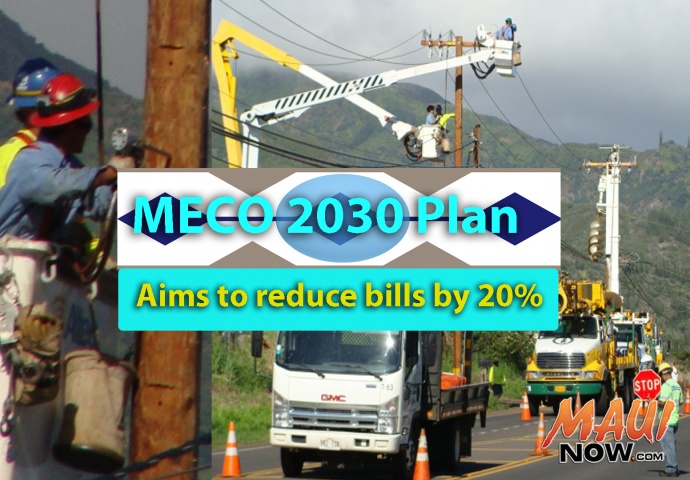2030 Electric Company Plan Aims to Reduce Bills by 20%
By Maui Now Staff
Hawaiian Electric Companies submitted a plan to the Public Utilities Commission that is designed to achieve specific goals by 2030 for Hawaiʻi’s Energy Future.
Company officials say highlights of the plan include:
- achieving more than 65% renewable energy;
- reducing electric bills by 20%; and
- nearly tripling the amount of distributed solar.
According to data released by the company, 18% of electricity used by customers currently comes from renewable sources.
Hawaiian Electric Companies, which includes the Maui Electric, Hawaiian Electric, and Hawaiʻi Electric Light Company subsidiaries, submitted the plan in an attempt to address orders issued by the Public Utilities Commission.
In April, the Hawaiʻi Public Utilities Commission announced four major decisions and orders that are aimed at providing key policy, resource planning, and operational directives to the Hawaiian Electric Companies.
One of the orders specifically involved Maui Electric Company, and directed the subsidiary to file a Power Supply Improvement Plan to address shortcomings of a System Improvement and Curtailment Reduction plan as part of a 2012 Test Year Rate Case.
“Our energy environment is changing rapidly and we must change with it to meet our customers’ evolving needs,” said Shelee Kimura, Hawaiian Electric vice president of corporate planning and business development in a company press release detailing the proposed plan. “These plans are about delivering services that our customers value. That means lower costs, better protection of our environment, and more options to lower their energy costs, including rooftop solar.”
Company executives anticipate that the plan will help the state achieve “the highest level of renewable energy in the nation by 2030.”
The company released a list of highlights that are designed to help meet the goals set forth in the plan including the following:
- Support sustainable growth of rooftop solar: The solar industry is planning to nearly triple the amount of distributed solar by 2030. In an effort to accomplish this, an open planning process will be used to let customers and solar contractors know how much more solar can be added each year. Company officials intend to work on grid enhancements to enable the increase solar power integration.
- Expand use of energy storage systems: Company officials say Hawaiian Electric is evaluating proposals for energy storage projects on Oʻahu to be in service by early 2017; and energy storage projects are also in the works for Maui, Molokaʻi, Lānaʻi and Hawaiʻi Island. According to the report, energy storage systems, including batteries, “will increase the ability to add renewables by addressing potential disruptions on electric grids caused by variable solar and wind power.”
- Empower customers by developing smart grids: Hawaiian Electric Companies is proposing installation completion of smart grids in Maui County and on Hawaiʻi Island by the end of 2017, and on Oʻahu by the end of 2018. Company executives say the grids, “will help customers monitor and control their energy use, enable more customer service options, make service more reliable, and improve integration of renewable energy.”
- Offer new products and services to customers: New options for taking advantage of lower-cost renewable energy includes the use of community solar and microgrids. “Voluntary demand response programs will provide customers financial incentives for helping manage the flow of energy on the grid,” the announcement said.
- Switch from high-priced oil to lower cost liquefied natural gas: The company proposes to meet energy needs not met by renewables in large part through liquefied natural gas, which they say is cleaner and less expensive. According to the announcement, most existing oil-fired generating units will be converted to run on liquefied natural gas, and older generating units will be deactivated by 2030 as new, more-efficient, generators come online.
“Achieving this transformation requires significant upfront investment by the utilities and unaffiliated companies to build the necessary flexible, smart, and renewable energy infrastructure to continue to provide reliable service to customers,” the announcement said. “Customer bills are expected to decline, with some fluctuations, by an estimated 20% by 2030,” according to Hawaiian Electric Companies.
“It’s the start of a conversation that all of us – utilities, regulators and other policymakers, the solar industry, customers and other stakeholders – need to be a part of, as we work together to achieve the energy future we all want for Hawai‘i,” said Hawaiian Electric president and chief executive officer Dick Rosenblum in the press release statement.











